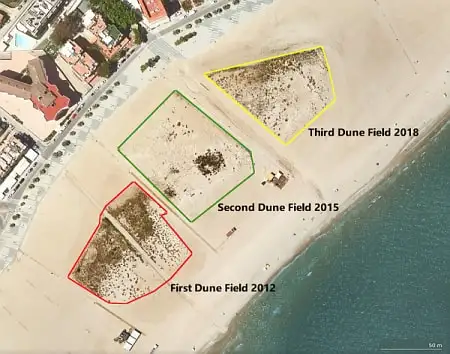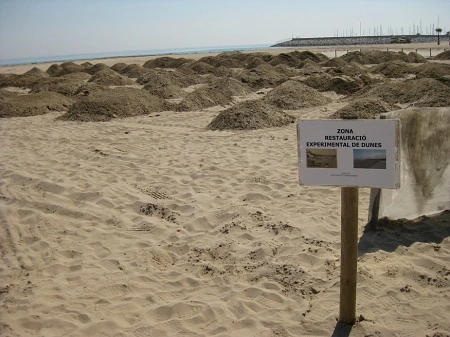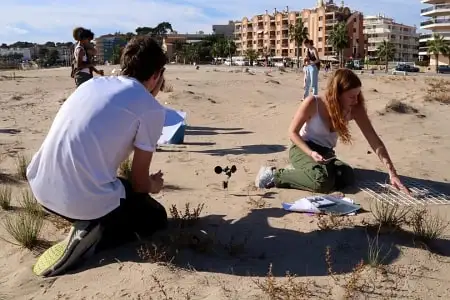Experimental Dune Fields Project, Torredembarra
Three experimental dune fields have been created on an urban beach at Torredembarra, with the aim of restoring a sand dune ecosystem that has practically disappeared throughout Spain. The experiments differ in their methodology, providing the opportunity to investigate the most effective methods in recreating an ecosystem where natural dune succession processes can occur.
These are innovative experiments, developed over a period of six years. The experimental dune fields are each approximately 2000 square metres in dimension, adjacent to each other and protected by fencing.
 The location of the three experimental dune fields |
- Field 1: developed in 2012 using sand dredged from the adjacent marina. It was planted with species indigenous to the natural dunes at nearby Muntanyans. This field is affected by an urban drainage channel that exits the town between dune fields 1 and 2.
- Field 2: developed in 2015, from Mediterranean seagrass meadow debris washed ashore and allowed to remain on the beach to fix the dunes. Up to this point, the dead seagrass had been removed by the daily beach cleaning teams.
- Field 3: a third area of beach was protected by fencing in 2018 and dunes allowed to develop naturally.
First Experimental Dune Field 2012
 First experimental dune field, March 2012 |
The first experimental dune field, covering an area of 2,631 m², was enclosed in March 2012. It involved the dredging and transfer of 300 m³ sand from the Torredembarra marina to create 116 small artificial dunes.
To fix the dunes, indigenous vegetation from the natural dunes at nearby Muntanyans were used in the experiment. In total, 1,400 species were planted. The initial survival rate exceeded 70%. New plants have arrived spontaneously and the dunes are being visited by birds such as the black-backed warbler or the threatened Corsican seagull.
 First experimental dune field, April 2012 |
Second Experimental Dune Field 2015
In 2015, an adjacent area of beach of approximately 2,000 m² was set aside for a second experimental trial. This trial involved the development of natural dunes fixed by Mediterranean seagrass, Cymodosea nodosa, washed ashore during storms. Instead of cleaning from the beach, the plant remains were left, which served to anchor the sand and start the process of dune formation.
-fixing-embryo-dunes.jpg) Mediterranean seagrass (Cymodosea nodosa) contribute to the fixing of embryo dunes |
 Cymodosea nodosa was spread across small excavated mounds of sand |
In less than three months, dunes began to develop with the arrival of two types of native plants and a Kentish Plover (Charadrius alexandrinus) nested in the area.
As a seagrass, Cymodosea nodosa is restricted to growing in shallow water and is one of the few Mediterranean plants that flower underwater. It forms meadows on the seabed which are an important rearing ground for juvenile fish.
When washed ashore, the seagrass offers resistance to the wind, creating a suitable microenvironment for the formation of the first pioneering dunes colonized by sand couch (Agropyrum junceum), Sporobolus pungens and Cutandia maritime.
Third Experimental Dune Field 2018
A third experimental field was created in 2018, with an area similar in size to the other two, protected by fencing and left to develop naturally.
Access to the Dunes
Access to the dunes is by permit only and permission is not granted during March-August, the nesting season of the Kentish Plover. This bird is regarded as a flagship indicator to the health and biodiversity of the dune ecosystem in Southern Catalonia. It is considered in danger of extinction according to the SEO Birdlife Association Red Book of Spanish Birds.
 Student group working in an experimental dune field at Torredembarra, November 2022 |
Dune data
Data collected should be passed to us as soon as possible after your visit for forwarding to the experiment monitoring group GEPEC-EdC.
Credits
The project exists thanks to the strong support of Torredembarra Town Council and Ramon Ferré, director of the experimental dune field project and member of GEPEC-EdC. GEPEC-EdC is the Group for the Study and Protection of Catalan Ecosystems-Ecologists of Catalonia.
The work associated with the experimental dune fields relies on the help of volunteers, with the first dune field financed, in part, with a grant of 3,000 euros from Ministry of the Environment.
Torredembarra receives the first students of the experimental dune fields project